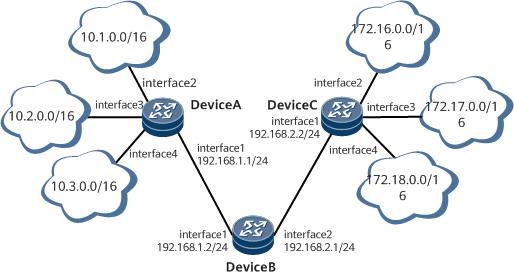Example for Preventing Routing Loops
This section uses split horizon as an example to describe how to prevent routing loops.
Networking Requirements
On the network shown in Figure 1, IP addresses have been configured for interfaces on all routers, RIP-2 has been configured on each router, and RIP services are running properly. Classful summarization is enabled on router A and router C. It is required that split horizon be configured on router A and router C.

On a RIP-2 network, if classful summarization is configured, you need to disable split horizon and poison reverse. After classful summarization is disabled, you need to reconfigure split horizon or poison reverse to prevent routing loops. This section uses split horizon as an example.
Precautions
When preventing routing loops, note the following rules:
If both split horizon and poison reverse are configured, only poison reverse takes effect.
Configuration Roadmap
The configuration roadmap is as follows:
- Disable route summarization.
- Enable split horizon.
Data Preparation
To complete the configuration, you need the following data:
RIP network segments 10.1.0.0, 10.2.0.0, 10.3.0.0, and 192.168.0.0 on DeviceA
RIP network segment 192.168.0.0 on DeviceB
RIP network segment 172.16.0.0, 172.17.0.0, 172.18.0.0, and 192.168.0.0 on DeviceC
IP addresses of each interface
Procedure
- Disable route summarization.
# Disable route summarization on Device A.
[~DeviceA] rip 1 [*DeviceA-rip-1] undo summary [*DeviceA-rip-1] commit [~DeviceA-rip-1] quit
# Disable route summarization on Device B.
[~DeviceB] rip 1 [*DeviceB-rip-1] undo summary [*DeviceB-rip-1] commit [~DeviceB-rip-1] quit
- Configure split horizon.
Configure split horizon on the RIP interfaces of all routers. The configurations on Device B and Device C are similar to the configuration on Device A. For configuration details, see Configuration Files in this section.
# Configure Device A.
[~DeviceA] interface gigabitethernet0/1/0 [~DeviceA-GigabitEthernet0/1/0] rip split-horizon [*DeviceA-GigabitEthernet0/1/0] quit [*DeviceA] interface gigabitethernet0/1/1 [*DeviceA-GigabitEthernet0/1/1] rip split-horizon [*DeviceA-GigabitEthernet0/1/1] quit [*DeviceA] interface gigabitethernet0/1/2 [*DeviceA-GigabitEthernet0/1/2] rip split-horizon [*DeviceA-GigabitEthernet0/1/2] quit [*DeviceA] interface gigabitethernet0/1/3 [*DeviceA-GigabitEthernet0/1/3] rip split-horizon [*DeviceA-GigabitEthernet0/1/3] quit [*DeviceA] commit
- Verify the configuration.
# Run the display rip 1 interface verbose command on Device A and Device C. You can check whether split horizon is enabled. Use the command output on Device A as an example. If the displayed Split-Horizon field is Enabled, split horizon has been enabled.
[~DeviceA] display rip 1 interface verbose GigabitEthernet0/1/0(192.168.1.1) State : DOWN MTU: 500 Metricin : 0 Metricout: 1 Input : Enabled Output : Enabled Protocol : RIPv2 Multicast Send : RIPv2 Multicast Packets Receive : RIPv2 Multicast and Broadcast Packets Poison-reverse : Disabled Split-Horizon : Enabled Authentication type : None Replay Protection : Disabled Max Packet Length : 512 GigabitEthernet0/1/1(10.1.1.1) State : DOWN MTU: 500 Metricin : 0 Metricout: 1 Input : Enabled Output : Enabled Protocol : RIPv2 Multicast Send : RIPv2 Multicast Packets Receive : RIPv2 Multicast and Broadcast Packets Poison-reverse : Disabled Split-Horizon : Enabled Authentication type : None Replay Protection : Disabled Max Packet Length : 512 GigabitEthernet0/1/2(10.2.1.1) State : DOWN MTU: 500 Metricin : 0 Metricout: 1 Input : Enabled Output : Enabled Protocol : RIPv2 Multicast Send : RIPv2 Multicast Packets Receive : RIPv2 Multicast and Broadcast Packets Poison-reverse : Disabled Split-Horizon : Enabled Authentication type : None Replay Protection : Disabled Max Packet Length : 512 GigabitEthernet0/1/3(10.3.1.1) State : DOWN MTU: 500 Metricin : 0 Metricout: 1 Input : Enabled Output : Enabled Protocol : RIPv2 Multicast Send : RIPv2 Multicast Packets Receive : RIPv2 Multicast and Broadcast Packets Poison-reverse : Disabled Split-Horizon : Enabled Authentication type : None Replay Protection : Disabled Max Packet Length : 512
Configuration Files
Device A configuration file
# sysname DeviceA # interface GigabitEthernet0/1/0 undo shutdown ip address 192.168.1.1 255.255.255.0 rip version 2 multicast # interface GigabitEthernet0/1/1 undo shutdown ip address 10.1.1.1 255.255.0.0 rip version 2 multicast # interface GigabitEthernet0/1/2 undo shutdown ip address 10.2.1.1 255.255.0.0 rip version 2 multicast # interface GigabitEthernet0/1/3 undo shutdown ip address 10.3.1.1 255.255.0.0 rip version 2 multicast # rip 1 network 10.1.0.0 network 10.2.0.0 network 10.3.0.0 network 192.168.0.0 return
Device B configuration file
# sysname DeviceB # interface GigabitEthernet0/1/0 undo shutdown ip address 192.168.1.2 255.255.255.0 rip version 2 multicast # interface GigabitEthernet0/1/1 undo shutdown ip address 192.168.2.1 255.255.255.0 rip version 2 multicast # rip 1 network 192.168.0.0 return
Device C configuration file
# sysname DeviceC # interface GigabitEthernet0/1/0 undo shutdown ip address 192.168.2.2 255.255.255.0 rip version 2 multicast # interface GigabitEthernet0/1/1 undo shutdown ip address 172.16.1.1 255.255.0.0 rip version 2 multicast # interface GigabitEthernet0/1/2 undo shutdown ip address 172.17.1.1 255.255.0.0 rip version 2 multicast # interface GigabitEthernet0/1/3 undo shutdown ip address 172.18.1.1 255.255.0.0 rip version 2 multicast # rip 1 network 172.16.0.0 network 172.17.0.0 network 172.18.0.0 network 192.168.0.0 return
